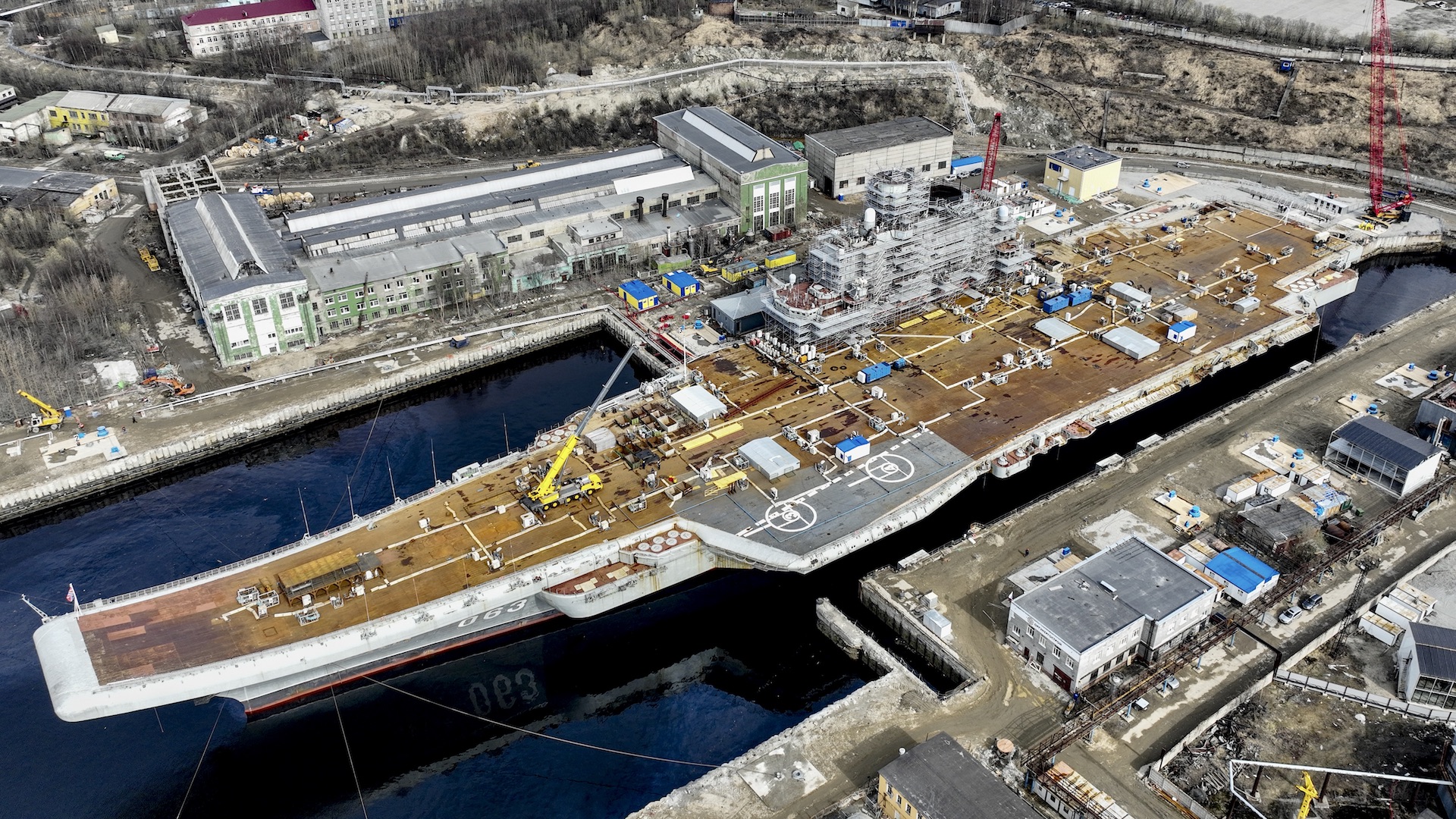Russia’s only aircraft carrier, Admiral Kuznetsov, currently doesn’t have a crew. This adds another hurdle to getting the ship, which finally departed its drydock at the Sevmorput Naval Shipyard in Russia’s northwestern Murmansk region in February, into any kind of real service. Since 2017, Admiral Kuznetsov has been undergoing a labored overhaul effort, during which time it has suffered multiple fires and a drydock sinking.
The Russian newspaper Izvestia first reported on April 10 that Admiral Kuznetsov’s crew is in the process of being reformed. According to a machine translation of the article, anonymous sources within the Russian Defense Ministry confirmed to the newspaper that preparations for the formation of Admiral Kuznetsov’s new crew have begun, although when exactly this started remains unclear. It’s also uncertain when this process will be finalized, owing to the significant challenges of finding and training the personnel needed to man the vessel.

The size of the new crew, according to Izvestia, will be in the region of 1,500 personnel. This is slightly less than the vessel’s previous crew complement, which the article and other sources suggest stood in excess of 1,900 personnel. According to Izvestia, the reduced crew size is due to the installation of “new automated systems and units” on the vessel. Admiral Kuznetsov is expected to feature updated electrical equipment and defensive systems, among other enhancements.
In addition to the maritime positions that need to be filled – including officers, midshipmen sailors, motorists, navigators and signalmen – specialists in the operation and maintenance of aviation equipment will also need to be recruited, Izvestia notes, indicating that these positions are not immediately available to be filled.

The challenges ahead for Russia’s Defense Ministry in reforming Admiral Kuznetsov’s crew shouldn’t be underestimated, particularly in light of wider military personnel shortages ongoing in the context of the current war in Ukraine.
This could well have an impact when the vessel is expected to return to service. As The War Zone previously indicated, Admiral Kuznetsov’s return to Russia’s combat fleet is planned for 2024. The ship was originally meant to have finished its overhaul in 2021, but this was delayed at least in part due to a series of incidents since 2017 – including the accidental sinking of its original PD-50 drydock in 2018, followed by two fires that broke out on the vessel in 2019 and then again in 2022.
It should be noted that Admiral Kuznetsov had seen its fair share of accidents before 2017, too. An onboard fire, which occurred off Turkey in 2009, for example, led to the deaths of several crew members, while in late 2016, two of its fighter jets were lost mere days apart while supporting combat operations in Syria.

On top of this are the additional challenges of training new crew members on specialized equipment, which could lead to further risks. Indeed, as Matus Smutny (@Saturnax1 ), Russian Naval history expert and contributor to The War Zone, told us:
“Even if 1,500 suitable sailors [are found], their training and familiarization [with the carrier would] take months, as Kuznetsov is Russia’s largest surface vessel. Even the old crew would struggle to learn how to properly operate the newly installed equipment. Improperly trained crew leads to workplace complacency and that leads to a major accident.”
Bringing in skilled officers from other vessels to begin with, on a rotational basis, may be required to ensure Admiral Kuznetsov is roughly operational, Smutny highlights.

While this may be of benefit to basic operations, the need for carrier-specific training remains paramount in this context, with Admiral Kuznetsov requiring a crew complement with various specialized personnel to execute carrier-specific roles.
Moreover, aircrews previously tied to the carrier prior to 2017 will need to re-qualify for carrier operations, too. These Su-33 and MiG-29KR units will have not actually operated from the carrier for over seven years by the time the ship is operational again, assuming everything goes right. None of this should be insurmountable, but it will feature elevated risk and will be resource intensive.
It isn’t just Admiral Kuznetsov facing these issues, Smutny notes. “Sevmash Shipyard is reportedly finishing the upgrade of the Project 1144.2M Orlan/Kirov-class nuclear-powered battlecruiser Admiral Nakhimov. She has been stuck at Sevmash since 1999 so, obviously, her former crew is gone. The Russian Navy will need another 800 sailors to be trained to operate her once she’s recommissioned.”
Nakhimov‘s sister ship has been in continuous operation though, so the institutional knowledge of how to operate a Russian nuclear ‘battle cruiser’ should still be accessible.
“Apart from Kuznetsov and Nakhimov, Russia is commissioning other new units at +/- the same rate as before Feb. 22 – their naval schools are still training new officers, but will struggle to supply the number of required professionals to catch up with the Kuznetsov and Nahkimov recommissioning,” he said.

Although the overhaul is intended to keep Admiral Kuznetsov in service for possibly another decade or more, funds devoted to it could have been used to actualize more usable and sustainable efforts, as The War Zone has pointed out in the past. Moreover, there will likely be additional costs in sustaining the carrier’s air wing as well – the status of which remains murky.
Above all else, the sourcing of thousands of sailors to get two of the Russian Navy’s most complex and biggest Cold War ships back into action comes at a time when Moscow is conscripting hundreds of thousands to fight in Ukraine. Allocating very large sums of personnel to things like aircraft carriers or battle cruisers that cannot take part in any way in that all-out war is dubious at best.
That said, time is ticking on the aim of returning Admiral Kuznetsov to Russia’s combat fleet next year. We’ll keep our eyes peeled for what developments await the vessel next.
Contact the author: oliver@thewarzone.com, joe@thedrive.com, tyler@thedrive.com
